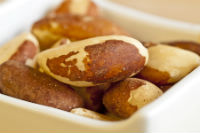Brazil Nut Butter
/Making freshly ground nut butters at home gives you the opportunity to enjoy these nutritious spreads without added sugar, salt, or preservatives often found in store-bought varieties.
Note: There is a 2 to 1 ratio of nuts to nut butter. To make 1 cup of nut butter, start with 2 cups of shelled nuts.
Ingredients:
- 2 cups organic raw nuts
- Optional flavor add-ins (all to taste; opt for organic or locally sourced):
- Salt
- Stevia, honey or maple syrup
- Vanilla or almond extract
- Cocoa powder or cacao nibs*
- Puree of dried fruit or dried fruit bits* (apricot, raisin, cherry, cranberry)
*The former creates a smooth spread, the latter chunky.
Original preparation:
- To make the nuts more digestible, soak and dehydrate the nuts to extract phytic acids (compounds that bind minerals). Before grinding, soak nuts in water and cover for 8-12 hours. Dehydrate about 10 hours.
- To add a distinctive, warm flavor, toast the nuts before grinding. Toast nuts on a dry baking sheet at 400°F until nuts are fragrant and lightly browned, 5 to 10 minutes. Watch closely; nuts easily scorch. Nuts should be cool to the touch before grinding.
Equipment:
Food processor or high-speed blender (e.g., Vitamix).
Directions:
Place nuts into a food processor and start blending, leaving out the optional flavor add-ins. Blend for 11-12 minutes. You may need to grind at various speeds or intervals until you reach the consistency that meets your taste preferences. The nuts will go through several stages and you'll need to keep pressing the contents into the center of the blender as you go through the process. The nuts will crumble, clump, ball, redistribute, and then finally ... the oils will release, and you'll have a nice spread.
Mix in your choice of flavor add-ins by hand. Nut butter keeps in the refrigerator for about a month.
Resources:
- Anton Health and Nutrition. "Homemade Nut Butter." Radiant Life Company. "That's Nuts! A Complete Guide to Soaking Nuts and Seeds."
Image Attribution: Robyn Mackenzie/bigstockphoto.com


